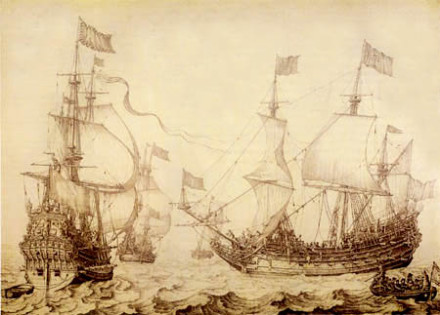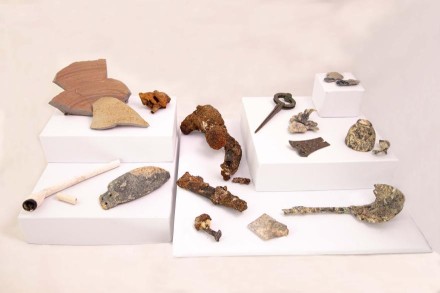History
The Vergulde Draeck sailed in October 1655 from Holland to the East Indies, bound for Batavia, what is now Jakarta, with a cargo valued at around fl. 185,000. From the Cape of Good Hope, she had to travel around miles east before turning north to head for the East Indies.
Unfortunately, The Vergulde Draeck sailed too far east and met the Western Australian coast. On the 28th April, 1656, she struck a reef near the Suydland (Australia). Only 75 of the original 193 men on board made it to the shore.

Seven sailors were sent to Batavia in an open boat in search of help. They reached Batavia after 41 days. The Dutch authorities sent two ships to retrieve the cargo (minted silver along with cargo worth 90,000 euros) and the crew, but the ships did not succeed. Two more expeditions were sent, but both failed to recover any members of the missing crew.
Description
This vessel was not built at the VOC shipyard in Amsterdam. It was bought on 23-1-1653 in Sardam and was given the name Vergulde Draeck on 10-3-1653. [NA 1.04.02 (VOC) 234 resolutie kamer Amsterdam (scan 303)]
Tonnage: 130 last

| Skipper | Pietersz, Albert |
|---|---|
| People on board | 193 |
Status
The wreck, the first of the Dutch and English East India ships found on the Western Australian coast, was discovered by five spear-fishermen (John Cowen; Jim, Alan and Graeme Henderson; and Alan Robinson ) in April 1963. After a period in which both it and the Batavia, (which was found later in the same year) were heavily looted shipwreck legislation was enacted, vesting the sites in the Western Australian Museum. Subsequently the remains were excavated by Jeremy Green and a report was published. Materials from the wreck are on exhibition.
Protected by law: Historic Shipwreck Act 1976.
Survivor camp excavated in 2025
In 2022, lead spring shot was found at a coastal location near the Vergulde Draeck shipwreck, providing clues on the movements of survivors after the wrecking. To follow, in 2024, another set of artefacts were found in the vicinity by a different member of the public.

The lead spring shot and other small canon balls of The Vergulden Draeck
The 2024 artefacts include a pair of navigational dividers, stoneware sherds, a brass clasp and a lead fishing sinker, and are consistent with items held in the WA Museum, Vergulde Draeck collection.

All artefacts found in 2022 and 2024 were handed in to the WA Museum for further archaeological investigation and to be registered into the State Maritime Heritage Collection. The finding of 17th century Dutch artefacts in 2022 and 2024, supported by archaeological excavation in 2025, provides evidence for the discovery of a survivor camp associated with the Dutch ship.

A canon of the Vergulde Draeck on the wrecksite
References
- DAS 0833.2.
- Western Australian Museum.
Vergulde Draeck Shipwreck. - Western Australian Museum.
Vergulde Draeck Collection Highlights. - pp 489 e.v.
nationaalarchief.
VOC.
1225.